Today's online documents are like yesterday's
paper—flat, lifeless, inactive. Instead, CDF puts easy-to-author
interactivity at its core, empowering readers to drive content and
generate results live.
Launched by the Wolfram Group, the CDF standard is a
computation-powered knowledge container—as everyday as a document, but
as interactive as an app.
Adopting CDF gives ideas a broad communication pipeline—accelerating research, education, technical development, and progress.
 |
| Click to enlarge |
Why Use the Computable Document Format (CDF)?
CDF offers content creators easy-to-author
interactivity and convenient deployment options—empowering their readers
to drive content and generate results live.
Key Advantages of CDF:
Broader communication pipeline: Create content as everyday as a document, but as interactive
as an app.
Built-in computation: Let the reader drive new discovery—live.
Easy-to-author interactivity: Use automated functions and plain English input instead of specialist programming skills for a wide range of applications.
Deployment flexibility: Create once—deploy as slide shows, reports, books, applications, and web objects.
Integrated knowledge: Access specialized algorithms, data, and visualizations for hundreds of subjects
Features of CDF Documents
From bloggers, students, and teachers to business
consultants, scientists, engineers, or publishers, CDF delivers features
that far surpass those of traditional document formats.
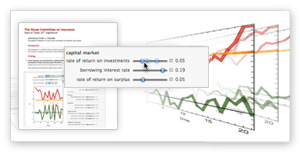
| 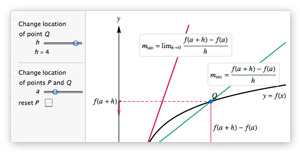
| |
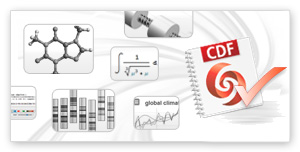
| 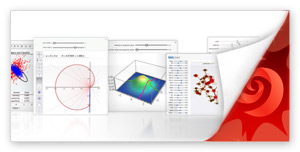
|
The Power behind CDF
CDF is built on the same technologies that are behind Mathematica—the
world's leading computation platform—and Wolfram|Alpha—the world's
first computational knowledge engine. Every CDF comes with the
technology innovations that Wolfram has brought to the world for
decades.

| 
| |
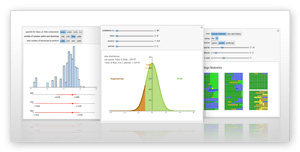
| 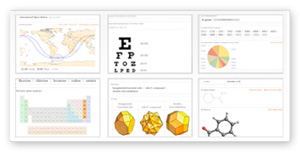
| |

| 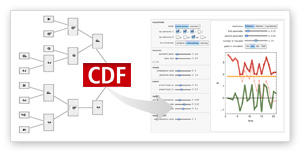
|
Getting Started with CDF
You can create CDFs with Mathematica 8. Additional creation methods will be coming in the future, ranging from Wolfram|Alpha to on-demand online Mathematica services.
How to Get Started:
1. Watch brief videos: Creating a Knowledge App in 60 Seconds and Making Documents Interactive with CDF.
2. Download a free trial of Mathematica 8 to create your own CDFs. Comprehensive documentation is available on how to create CDFs, interactive controls, and many other topics.
3. Repurpose the source code of thousands of CDFs available from the Wolfram Demonstrations Project. For example, a Demonstration's source could be as straightforward as the code shown below.
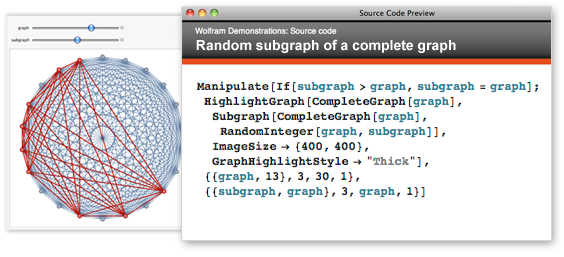
4. Want to learn more? Online CDF courses are coming soon
Deploying CDF
Deploy CDFs as full pages or embedded objects within a web browser, or as desktop applications or documents.
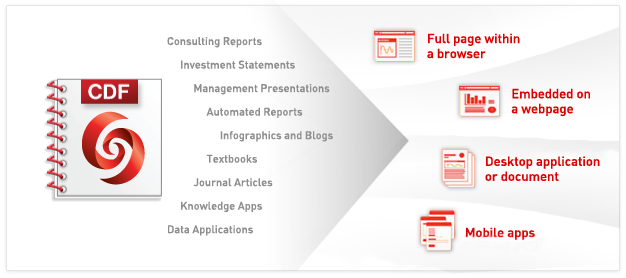
Our FreeCDF terms allow you to share your CDFs with anyone for non-commercial use. See the license summary for details.
Typical Uses of FreeCDF:
- Add calculators to your blog
- Make executive reports into interactive presentations
- Turn your lecture notes into an interactive website
- Transform your lab notebook into a slide show with dynamic computations
CDF Product Icons
Wolfram provides three types of web icons that you can use on your site:
CDF icons indicate that a CDF file is available for download or for using in the web browser.
Get CDF Player icons provide a convenient link to the Wolfram CDF Player download site.
Powered by Wolfram CDF icons indicate that your site uses CDF or includes a CDF application.
Platform Support for CDF
For Windows and Mac OS X, Wolfram CDF Player offers desktop and web plugin functionality. On Linux systems, CDF Player currently supports desktop functionality only.
The web plugin has been tested with the following browsers:
Windows 7/Vista/XP: Internet Explorer, Firefox, Chrome, Opera, Safari
Mac OS X 10.5+: Safari, Firefox, Chrome(4.0+), Opera(10.5+)
Linux 2.4+: Desktop functionality only

System requirements:
Processor: Intel Pentium III 650 MHz or equivalent
System Memory (RAM): 512 MB required; 1 GB+ recommended
CDF on Mobile Devices
We are actively pursuing solutions for mobile devices, including
cloud-based services, to make CDF available to anyone, anywhere.
The iPad is an important part of our CDF strategy for accessing
educational apps, business reports, and other interactive computational
material.